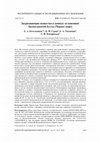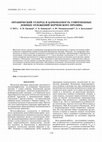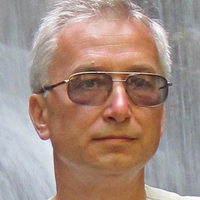Papers by Ekaterina A. Kotel'yanets
Geochemistry International, 2015
Data on the abundance and distribution of organic carbon and carbonates in the recent bottom sedi... more Data on the abundance and distribution of organic carbon and carbonates in the recent bottom sediments of the Kerch Strait were analyzed. It was shown that the content of organic carbon in the bottom sediments of the navigable part of the strait adjacent to the Kerch Peninsula is currently 1.5–2.0 times higher than the values obtained in the 1970s and organic carbon contents in the modern bottom sediments from the part of the strait adjacent to the Taman Peninsula. This is explained by the spatial distribution of the grain-size composition of bottom sediments in the strait and changes in the sedimentation conditions due to anthropogenic activities. As possible environmental consequences of such changes, we discussed the formation of hypoxia zones and increasing risk of asphyxiation phenomena in the strait.
Physical Oceanography, 2015

Morskoy gidrofizicheskiy zhurnal
The purpose of the paper consists in studying the pollution level, and the character of spatial d... more The purpose of the paper consists in studying the pollution level, and the character of spatial distribution of microelements and trace metals, the chlorophorm-extractable substances and petroleum hydrocarbons and in evaluating the features of their accumulation in the upper layer of bottom sediments in the Balaklava Bay depending on the natural and anthropogenic sources of pollutants. Methods and Results. The samples were taken from the bottom sediments upper layer (0-5 cm) in the Balaklava Bay by the Peterson grabber in February, 2015. Location of the sampling stations was chosen proceeding from the features of the bay morphometry, hydrological and hydrochemical water structure, pollution sources and the character of the sedimentation processes. The samples were selected, preprocessed and analyzed by the standard methods according to the regulatory documents. Some changes in relation between the clay fractions and the gravel material composition were revealed. The correlation dependence between the contents of chlorophorm-extractable substances and petroleum hydrocarbons was calculated. The features of spatial distribution of the metals' content depending on the natural geochemical processes in the bottom sediments are revealed. The regions subjected to the most intensive anthropogenic load within the region under study are distinguished. Conclusions. The content of clay material in all the samples taken in the Balaklava Bay on the average increased from 58.2 to 65.9 % and its maximum values are still concentrated in the western and northwestern parts of the water area under study. During last ten years, growth of the portion of a fine-grained material in the bottom fractions has been noted; at that the places where it accumulats are located in the areas of intense anthropogenic activity. The chlorophorm-extractable substances concentration in the Balaklava Bay bottom sediments varied within a wide range. On the whole, in course of the investigated period their content decreased, whereas the petroleum hydrocarbons concentration remained unchanged. It is found that pollution of the bottom sediments by metals is of a polyelemental nature and is characterized primarily by such metals as Pb, Cr, Zn, Cu and Sr. The increased microelements concentrations are observed in the northeastern and central parts of the water area, whereas the decreased metal concentrationsin its northwestern and eastern parts.

Поступила в редакцию 09.07.2013 г. Принята к печати 18.11.2013 г.; после доработки Выполнен анали... more Поступила в редакцию 09.07.2013 г. Принята к печати 18.11.2013 г.; после доработки Выполнен анализ данных о содержании и распределении органического углерода и величины карбо натности в современных донных отложениях Керченского пролива. Показано, что содержание орга нического углерода в донных отложениях судоходной части пролива, примыкающей к Керченскому полуострову, в настоящее время превышает в 1.5-2 раза значения, полученные в 70 х годах ХХ ст., а также содержание органического углерода в современных донных отложениях части пролива, примы кающей к Таманскому полуострову. Это объясняется пространственными особенностями грануло метрического состава донных отложений пролива, а также изменением условий осадконакопления под влиянием антропогенных факторов. Обсуждаются возможные экологические последствия таких изменений -образование зон гипоксии и повышения риска заморных явлений в проливе.
Data on the abundance and distribution of organic carbon and carbonates in the recent bottom sedi... more Data on the abundance and distribution of organic carbon and carbonates in the recent bottom sediments of the Kerch Strait were analyzed. It was shown that the content of organic carbon in the bottom sediments of the navigable part of the strait adjacent to the Kerch Peninsula is currently 1.5-2.0 times higher than the values obtained in the 1970s and organic carbon contents in the modern bottom sediments from the part of the strait adjacent to the Taman Peninsula. This is explained by the spatial distribution of the grain size composition of bottom sediments in the strait and changes in the sedimentation conditions due to anthropogenic activities. As possible environmental consequences of such changes, we discussed the forma tion of hypoxia zones and increasing risk of asphyxiation phenomena in the strait.
Physical and chemical characteristics of bottom sediments in the Balaklava Bay, namely, granulo-m... more Physical and chemical characteristics of bottom sediments in the Balaklava Bay, namely, granulo-metric and fractional compositions, and organic and inorganic carbon content are considered. Spatial distribution of the main fractions of granulometric composition, and content of organic carbon (TOC) and calcium carbonate (CaCO3) are investigated. Correlation between the content of organic and inorganic carbon and the granulometric composition of bottom sediments is analyzed. The major factors forming the bottom sediments in the Balaklava Bay are distinguished.








Uploads
Papers by Ekaterina A. Kotel'yanets